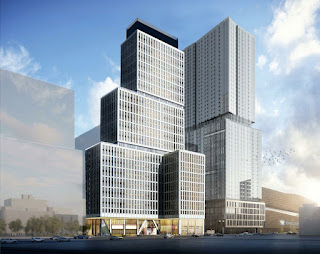While B5 tower could qualify for 421-a extension, the all middle-income "affordable" option is off the table. But Option B still looks pretty good, compared to 485-x.
In a previous version of the graphic describing plans for Atlantic Yards/Pacific Park, below, I assumed that the B5 tower, the first built over the railyard, would contain 30% affordable units at 130% of Area Median Income (AMI). Hence the green and red shading indicating a 70%/30% breakdown.
After all, that reflected predictions from the Downtown Brooklyn Partnership, as I wrote in December 2022, as the building--as with B4, B15, and B12/13--would take advantage of the 421-a tax break which, allows 130% AMI units as long as 30% of the total apartments are below-market.
.png) |
| Outdated graphic by Ben Keel & Norman Oder |
That won't happen, though it's the deadline hasn't yet expired.
Because the building (apparently) had foundations installed by June 15, 2022, it could qualify for the 421-a tax break as it existed then, but only if it were completed by June 15, 2026.
That deadline won't be met without 24/7 construction and a miracle. Building even a piece of the platform, plus the tower, would take far longer.
So now it's more accurate to consider B5 a question mark, as shown in the updated graphic below.
 |
| Updated graphic by Ben Keel & Norman Oder |
What about the extension?
The state Legislature, in passing the 485-x successor to 421-a, added five years, until June 15, 2031, to complete existing 421-a projects.
However, as Joel Kolkmann, Empire State Development's Senior VP, Real Estate, said at last week's Atlantic Yards Community Development Corporation meeting, the extension doesn't apply to projects that were taking advantage of the option of 30% middle-income units at 130% of AMI, "so they would have to adjust their income levels."
Rather, they could choose between Option A, which requires 25% affordability, including at least 10% at up to 40% of AMI, 10% at up to 60% of AMI, and 5% at up to 130% of AMI; and Option B, which requires 30% affordability, including at least 10% at up to 70% of AMI and 20% at up to 130% of AMI.
So the latter's less lucrative than 30% of the units at 130% of AMI, but maybe not that far off, compared with past buildings that qualified.
Consider: in 2020, 70% of AMI for a four-person household was $79,590, and a two-bedroom rented for $1,622. A two-bedroom for a household at 130% of AMI could rent for $3,235.
In 2022, 70% of AMI for a four-person household was $93,380, and a two-bedroom rented for $2,101. A two-bedroom for a household at 130% of AMI could rent for $3,903.
Today, in 2024, 70% of AMI for a four-person household is $108,710, and a two-bedroom could rent for $2,446. A two-bedroom for a household at 130% of AMI could rent for $4,543.
That's a blended average of $3,844, which is well above the 2020 figure for a 130% AMI unit and not far above the 2022 figure.
By 2027 or 2028, AMI will surely have risen, and the overall package might easily dwarf the previous rent levels.
The 485-x alternative
Alternatively, the builders of B5 could follow 485-x. As I wrote, more affordability is required.
The new buildings would have to deliver at least 25% affordability, with the weighted average of all income bands not exceeding 60% of AMI, with no more than three income bands, and no income band exceeding 100% of AMI.
Just based on AMI levels, the 421-a extension seems a much better bet.
Then again, the 40-year tax exemption under 485-x is more beneficial to builders than the previous 25-year full exemption, plus ten years of exemption applied to the affordable units.
But it also comes with another cost: wage floors for construction workers. "The extension allows some large projects to proceed while avoiding the upgraded wage requirements of 485-x," wrote the Manhattan Institute's Eric Kober. "This might make those projects financially feasible."
However, while affordable units under 485-x units will remain income-restricted in perpetuity, as noted by The Real Deal, those under 421-a can go to market-rate after the 35-year expiration of the tax break.
So presumably any builder would crunch the numbers.

Comments
Post a Comment